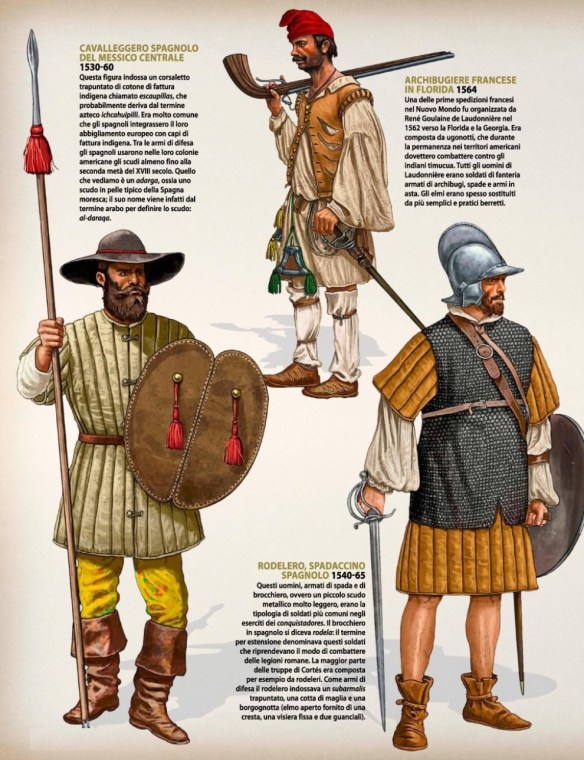Globally, one of the most important patterns that scholars highlight in the early modern era is the gradual unfolding of the “Military Revolution” in Europe-a profound military, political and socioeconomic transformation between the sixteenth and eighteenth centuries. Such an approach usually focuses on the European expansion around the world, in particular the Spanish conquests of the Aztec and Inca states and the arrival and establishment of European navies in the Indian Ocean, where local Islamic and Indian states proved to be unable to retain supremacy of the seas. Equally interesting, however, is the increasing ability of Europe to fight off the Ottoman attacks, clearly revealed when comparing the Christian failures of the early sixteenth century with successes of the seventeenth century.
The European conquests-of Cortes and Nuno de Guzman, in central Mexico, Pizzaro in Peru, Francisco and Pedro de Alvarado Orozco in Guatemala, or Francisco de Montejo in the Yucatan Peninsula to name just a few-consequently followed the pre-Columbian trade routes which greatly contributed to their success. From the earliest years of Spanish colonization of the western hemisphere, the Spaniards became aware of how quickly they could seize control over local population by capturing local leaders. This tactic may have had precedents in Spanish experiences with the Moors or in North Africa, but the surprise capture of the local ruler during a seemingly friendly negotiation became a standard. Thus, in 1519, Cortés, invited to an audience with the Aztec emperor Moctezuma II, captured the emperor in an attempt to seize control of the empire. His success inspired Francisco Pizzaro to capture the Inca leader Atahualpa in 1531.
Despite the popular perception of the Spanish conquistadors as invincible and gallant warriors, the real story of success lies in local elites’ early support for foreign invasions. Their motivation included both the desire to free themselves from existing military and tributary controls as well as the opportunity to aggrandize themselves with land and riches. Indeed, alliance-building was a fundamental practice in Mesoamerica, successfully used by the Aztecs in the form of the Triple Alliance (confederation of city-states of Tenochtitlan, Texcoco, and Tlacopan) to incorporate much of the region into their empire prior to Europeans’ arrival. When Cortés arrived in Mesoamerica in 1519, the Fat Cacique of Cempoala followed a long-standing alliance-building tradition in offering the Spaniard an alliance with Tlaxcala, Huexotzingo, and other city-states against the powerful Aztecs; the presence of tens of thousands of native soldiers allowed the Spaniards to bring down the Aztec empire.
Mesoamerican War Strategy, Battle Tactics, and Armaments
The Indians of pre-Hispanic Mexico developed strategic war aims, battlefield tactics, and arms and armaments to suit the societies they created. Aztec warfare, as well as that of other neighboring polities and cultures, primarily aimed to capture but not kill opposing warriors, who would then be sacrificed to various deities. Whereas Eurasian armies developed well-organized and highly maneuverable infantry and cavalry formations, the Aztecs and their neighbors, as well as all of their predecessors, lacked close-ordered drill and instead stressed charges and individual combat designed to win prestige by acquiring sacrificial victims. They still, however, also fought for larger objectives, namely conquest and subjugation, as representations of stylized burning temples and tribute lists in the few extant Mexica codices (bound books) make abundantly clear.
The Aztec (or Triple Alliance) order of battle illustrates the height of pre-Hispanic arms and armaments in Mesoamerica. The Aztecs fielded armies as large as 100,000 to 200,000 fighting men, divided into 8,000-man units. Lightly armed scouts and skirmishers, carrying atlatl launchers and spears, preceded the more heavily armed main body of warriors. These warriors wore quilted cotton armor; carried painted, sometimes feathered, round shields; and employed razor-sharp obsidian-bladed clubs and knives as well as slings, darts, and other weapons to make war. The highest-ranked among them, including commanders and members of prestigious military orders, such as the Otomi who were named after an especially fierce tribe of neighboring Indians, and at times the emperor himself wore elaborate feathered costumes and sandals. The more elite the military order, the more elaborate the feathered costume. Reserve forces, including conscripted troops from conquered provinces, followed.
Such formations failed to survive Spanish battlefield tactics and arms and armaments during the conquest of Mexico. While the Aztecs obsidian-bladed club could and did decapitate horses, it proved too unwieldy and could not match the Spaniards’ steel swords, which could parry, slash, and thrust, not to mention the Spaniards’ determination to destroy and not merely capture their opponents in war.
Bibliography Hassig, Ross. Aztec Warfare: Imperial Expansion and Political Control. Norman: University of Oklahoma Press, 1995. Padden, R. C. The Hummingbird and the Hawk: Conquest and Sovereignty in the Valley of Mexico, 1503-1541. New York: Harper and Row, 1970.
